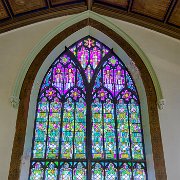
1 ST. JOHN’S CHRISTIAN METHODIST
EPISCOPAL CHURCH
8715 Woodward Avenue
Detroit, MI 48202
In 1917, the Reverend O. L. Mitchell established the first Colored Methodist Episcopal (CME) mission in Detroit. He selected the name St. John in honor of the Apostle who is credited with successfully establishing Christian churches throughout Asia Minor. The first CME church in Detroit was a brick church located near the intersection of DuBois and Catherine that had been erected in 1883 for the First German Evangelical Association Church. By 1920, a larger facility was needed, so the CME congregation purchased the former home of St. Mark’s English Evangelical Lutheran Church, also located near the intersection of Dubois and Catherine. The congregation used that facility until 1955 when they purchased the North Woodward Avenue Congregational building. With the move to the new location on June 5, 1955, St. John C.M.E. became the first Black congregation to be established in the “Piety Hill” section of Woodward.
The North Woodward Congregational Church was built in stages in the Neo Gothic style. A small chapel, designed by the firm of Malcomson and Higginbotham, was constructed early in 1907. The main sanctuary, designed by architect Hugh Barret Clement, was dedicated on February 5, 1911. On March 20, 1929, a permit was issued to architect A. R. Morison for the most recent addition, the church house. The three connected structures are built of red brick with limestone trim and a grey slate roof. Unlike many Gothic churches, it is a low-rise building lacking a bell tower. The projecting front gable wall containing a large Gothic-arched glass window dominates the Woodward Avenue facade.
The interior of the church is basilican in plan with a high central nave and lower side aisles. Large stained glass clerestory (upper) windows light the space which is finished in plaster with Gothic moldings. The organ is on the south side of the sanctuary facing the congregation, hidden behind a pierced wooden screen. The baptistery, a recess in the transept wall to the right of the chancel, is lined in mosaic tiles by Pewabic Pottery and surmounted by a Pewabic tile floor and beamed ceiling.
The official denominational name was changed to “Christian” in 1954. As the first C.M.E. church established in Michigan, it remains one of the largest and most well-known Christian Methodist congregations in the state.
EPISCOPAL CHURCH
8715 Woodward Avenue
Detroit, MI 48202
In 1917, the Reverend O. L. Mitchell established the first Colored Methodist Episcopal (CME) mission in Detroit. He selected the name St. John in honor of the Apostle who is credited with successfully establishing Christian churches throughout Asia Minor. The first CME church in Detroit was a brick church located near the intersection of DuBois and Catherine that had been erected in 1883 for the First German Evangelical Association Church. By 1920, a larger facility was needed, so the CME congregation purchased the former home of St. Mark’s English Evangelical Lutheran Church, also located near the intersection of Dubois and Catherine. The congregation used that facility until 1955 when they purchased the North Woodward Avenue Congregational building. With the move to the new location on June 5, 1955, St. John C.M.E. became the first Black congregation to be established in the “Piety Hill” section of Woodward.
The North Woodward Congregational Church was built in stages in the Neo Gothic style. A small chapel, designed by the firm of Malcomson and Higginbotham, was constructed early in 1907. The main sanctuary, designed by architect Hugh Barret Clement, was dedicated on February 5, 1911. On March 20, 1929, a permit was issued to architect A. R. Morison for the most recent addition, the church house. The three connected structures are built of red brick with limestone trim and a grey slate roof. Unlike many Gothic churches, it is a low-rise building lacking a bell tower. The projecting front gable wall containing a large Gothic-arched glass window dominates the Woodward Avenue facade.
The interior of the church is basilican in plan with a high central nave and lower side aisles. Large stained glass clerestory (upper) windows light the space which is finished in plaster with Gothic moldings. The organ is on the south side of the sanctuary facing the congregation, hidden behind a pierced wooden screen. The baptistery, a recess in the transept wall to the right of the chancel, is lined in mosaic tiles by Pewabic Pottery and surmounted by a Pewabic tile floor and beamed ceiling.
The official denominational name was changed to “Christian” in 1954. As the first C.M.E. church established in Michigan, it remains one of the largest and most well-known Christian Methodist congregations in the state.
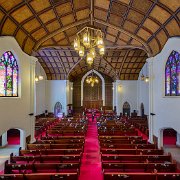
2 ST. JOHN’S CHRISTIAN METHODIST
EPISCOPAL CHURCH
8715 Woodward Avenue
Detroit, MI 48202
In 1917, the Reverend O. L. Mitchell established the first Colored Methodist Episcopal (CME) mission in Detroit. He selected the name St. John in honor of the Apostle who is credited with successfully establishing Christian churches throughout Asia Minor. The first CME church in Detroit was a brick church located near the intersection of DuBois and Catherine that had been erected in 1883 for the First German Evangelical Association Church. By 1920, a larger facility was needed, so the CME congregation purchased the former home of St. Mark’s English Evangelical Lutheran Church, also located near the intersection of Dubois and Catherine. The congregation used that facility until 1955 when they purchased the North Woodward Avenue Congregational building. With the move to the new location on June 5, 1955, St. John C.M.E. became the first Black congregation to be established in the “Piety Hill” section of Woodward.
The North Woodward Congregational Church was built in stages in the Neo Gothic style. A small chapel, designed by the firm of Malcomson and Higginbotham, was constructed early in 1907. The main sanctuary, designed by architect Hugh Barret Clement, was dedicated on February 5, 1911. On March 20, 1929, a permit was issued to architect A. R. Morison for the most recent addition, the church house. The three connected structures are built of red brick with limestone trim and a grey slate roof. Unlike many Gothic churches, it is a low-rise building lacking a bell tower. The projecting front gable wall containing a large Gothic-arched glass window dominates the Woodward Avenue facade.
The interior of the church is basilican in plan with a high central nave and lower side aisles. Large stained glass clerestory (upper) windows light the space which is finished in plaster with Gothic moldings. The organ is on the south side of the sanctuary facing the congregation, hidden behind a pierced wooden screen. The baptistery, a recess in the transept wall to the right of the chancel, is lined in mosaic tiles by Pewabic Pottery and surmounted by a Pewabic tile floor and beamed ceiling.
The official denominational name was changed to “Christian” in 1954. As the first C.M.E. church established in Michigan, it remains one of the largest and most well-known Christian Methodist congregations in the state.
EPISCOPAL CHURCH
8715 Woodward Avenue
Detroit, MI 48202
In 1917, the Reverend O. L. Mitchell established the first Colored Methodist Episcopal (CME) mission in Detroit. He selected the name St. John in honor of the Apostle who is credited with successfully establishing Christian churches throughout Asia Minor. The first CME church in Detroit was a brick church located near the intersection of DuBois and Catherine that had been erected in 1883 for the First German Evangelical Association Church. By 1920, a larger facility was needed, so the CME congregation purchased the former home of St. Mark’s English Evangelical Lutheran Church, also located near the intersection of Dubois and Catherine. The congregation used that facility until 1955 when they purchased the North Woodward Avenue Congregational building. With the move to the new location on June 5, 1955, St. John C.M.E. became the first Black congregation to be established in the “Piety Hill” section of Woodward.
The North Woodward Congregational Church was built in stages in the Neo Gothic style. A small chapel, designed by the firm of Malcomson and Higginbotham, was constructed early in 1907. The main sanctuary, designed by architect Hugh Barret Clement, was dedicated on February 5, 1911. On March 20, 1929, a permit was issued to architect A. R. Morison for the most recent addition, the church house. The three connected structures are built of red brick with limestone trim and a grey slate roof. Unlike many Gothic churches, it is a low-rise building lacking a bell tower. The projecting front gable wall containing a large Gothic-arched glass window dominates the Woodward Avenue facade.
The interior of the church is basilican in plan with a high central nave and lower side aisles. Large stained glass clerestory (upper) windows light the space which is finished in plaster with Gothic moldings. The organ is on the south side of the sanctuary facing the congregation, hidden behind a pierced wooden screen. The baptistery, a recess in the transept wall to the right of the chancel, is lined in mosaic tiles by Pewabic Pottery and surmounted by a Pewabic tile floor and beamed ceiling.
The official denominational name was changed to “Christian” in 1954. As the first C.M.E. church established in Michigan, it remains one of the largest and most well-known Christian Methodist congregations in the state.
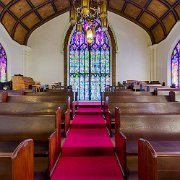
3 ST. JOHN’S CHRISTIAN METHODIST
EPISCOPAL CHURCH
8715 Woodward Avenue
Detroit, MI 48202
In 1917, the Reverend O. L. Mitchell established the first Colored Methodist Episcopal (CME) mission in Detroit. He selected the name St. John in honor of the Apostle who is credited with successfully establishing Christian churches throughout Asia Minor. The first CME church in Detroit was a brick church located near the intersection of DuBois and Catherine that had been erected in 1883 for the First German Evangelical Association Church. By 1920, a larger facility was needed, so the CME congregation purchased the former home of St. Mark’s English Evangelical Lutheran Church, also located near the intersection of Dubois and Catherine. The congregation used that facility until 1955 when they purchased the North Woodward Avenue Congregational building. With the move to the new location on June 5, 1955, St. John C.M.E. became the first Black congregation to be established in the “Piety Hill” section of Woodward.
The North Woodward Congregational Church was built in stages in the Neo Gothic style. A small chapel, designed by the firm of Malcomson and Higginbotham, was constructed early in 1907. The main sanctuary, designed by architect Hugh Barret Clement, was dedicated on February 5, 1911. On March 20, 1929, a permit was issued to architect A. R. Morison for the most recent addition, the church house. The three connected structures are built of red brick with limestone trim and a grey slate roof. Unlike many Gothic churches, it is a low-rise building lacking a bell tower. The projecting front gable wall containing a large Gothic-arched glass window dominates the Woodward Avenue facade.
The interior of the church is basilican in plan with a high central nave and lower side aisles. Large stained glass clerestory (upper) windows light the space which is finished in plaster with Gothic moldings. The organ is on the south side of the sanctuary facing the congregation, hidden behind a pierced wooden screen. The baptistery, a recess in the transept wall to the right of the chancel, is lined in mosaic tiles by Pewabic Pottery and surmounted by a Pewabic tile floor and beamed ceiling.
The official denominational name was changed to “Christian” in 1954. As the first C.M.E. church established in Michigan, it remains one of the largest and most well-known Christian Methodist congregations in the state.
EPISCOPAL CHURCH
8715 Woodward Avenue
Detroit, MI 48202
In 1917, the Reverend O. L. Mitchell established the first Colored Methodist Episcopal (CME) mission in Detroit. He selected the name St. John in honor of the Apostle who is credited with successfully establishing Christian churches throughout Asia Minor. The first CME church in Detroit was a brick church located near the intersection of DuBois and Catherine that had been erected in 1883 for the First German Evangelical Association Church. By 1920, a larger facility was needed, so the CME congregation purchased the former home of St. Mark’s English Evangelical Lutheran Church, also located near the intersection of Dubois and Catherine. The congregation used that facility until 1955 when they purchased the North Woodward Avenue Congregational building. With the move to the new location on June 5, 1955, St. John C.M.E. became the first Black congregation to be established in the “Piety Hill” section of Woodward.
The North Woodward Congregational Church was built in stages in the Neo Gothic style. A small chapel, designed by the firm of Malcomson and Higginbotham, was constructed early in 1907. The main sanctuary, designed by architect Hugh Barret Clement, was dedicated on February 5, 1911. On March 20, 1929, a permit was issued to architect A. R. Morison for the most recent addition, the church house. The three connected structures are built of red brick with limestone trim and a grey slate roof. Unlike many Gothic churches, it is a low-rise building lacking a bell tower. The projecting front gable wall containing a large Gothic-arched glass window dominates the Woodward Avenue facade.
The interior of the church is basilican in plan with a high central nave and lower side aisles. Large stained glass clerestory (upper) windows light the space which is finished in plaster with Gothic moldings. The organ is on the south side of the sanctuary facing the congregation, hidden behind a pierced wooden screen. The baptistery, a recess in the transept wall to the right of the chancel, is lined in mosaic tiles by Pewabic Pottery and surmounted by a Pewabic tile floor and beamed ceiling.
The official denominational name was changed to “Christian” in 1954. As the first C.M.E. church established in Michigan, it remains one of the largest and most well-known Christian Methodist congregations in the state.
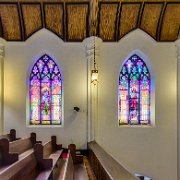
4 ST. JOHN’S CHRISTIAN METHODIST
EPISCOPAL CHURCH
8715 Woodward Avenue
Detroit, MI 48202
In 1917, the Reverend O. L. Mitchell established the first Colored Methodist Episcopal (CME) mission in Detroit. He selected the name St. John in honor of the Apostle who is credited with successfully establishing Christian churches throughout Asia Minor. The first CME church in Detroit was a brick church located near the intersection of DuBois and Catherine that had been erected in 1883 for the First German Evangelical Association Church. By 1920, a larger facility was needed, so the CME congregation purchased the former home of St. Mark’s English Evangelical Lutheran Church, also located near the intersection of Dubois and Catherine. The congregation used that facility until 1955 when they purchased the North Woodward Avenue Congregational building. With the move to the new location on June 5, 1955, St. John C.M.E. became the first Black congregation to be established in the “Piety Hill” section of Woodward.
The North Woodward Congregational Church was built in stages in the Neo Gothic style. A small chapel, designed by the firm of Malcomson and Higginbotham, was constructed early in 1907. The main sanctuary, designed by architect Hugh Barret Clement, was dedicated on February 5, 1911. On March 20, 1929, a permit was issued to architect A. R. Morison for the most recent addition, the church house. The three connected structures are built of red brick with limestone trim and a grey slate roof. Unlike many Gothic churches, it is a low-rise building lacking a bell tower. The projecting front gable wall containing a large Gothic-arched glass window dominates the Woodward Avenue facade.
The interior of the church is basilican in plan with a high central nave and lower side aisles. Large stained glass clerestory (upper) windows light the space which is finished in plaster with Gothic moldings. The organ is on the south side of the sanctuary facing the congregation, hidden behind a pierced wooden screen. The baptistery, a recess in the transept wall to the right of the chancel, is lined in mosaic tiles by Pewabic Pottery and surmounted by a Pewabic tile floor and beamed ceiling.
The official denominational name was changed to “Christian” in 1954. As the first C.M.E. church established in Michigan, it remains one of the largest and most well-known Christian Methodist congregations in the state.
EPISCOPAL CHURCH
8715 Woodward Avenue
Detroit, MI 48202
In 1917, the Reverend O. L. Mitchell established the first Colored Methodist Episcopal (CME) mission in Detroit. He selected the name St. John in honor of the Apostle who is credited with successfully establishing Christian churches throughout Asia Minor. The first CME church in Detroit was a brick church located near the intersection of DuBois and Catherine that had been erected in 1883 for the First German Evangelical Association Church. By 1920, a larger facility was needed, so the CME congregation purchased the former home of St. Mark’s English Evangelical Lutheran Church, also located near the intersection of Dubois and Catherine. The congregation used that facility until 1955 when they purchased the North Woodward Avenue Congregational building. With the move to the new location on June 5, 1955, St. John C.M.E. became the first Black congregation to be established in the “Piety Hill” section of Woodward.
The North Woodward Congregational Church was built in stages in the Neo Gothic style. A small chapel, designed by the firm of Malcomson and Higginbotham, was constructed early in 1907. The main sanctuary, designed by architect Hugh Barret Clement, was dedicated on February 5, 1911. On March 20, 1929, a permit was issued to architect A. R. Morison for the most recent addition, the church house. The three connected structures are built of red brick with limestone trim and a grey slate roof. Unlike many Gothic churches, it is a low-rise building lacking a bell tower. The projecting front gable wall containing a large Gothic-arched glass window dominates the Woodward Avenue facade.
The interior of the church is basilican in plan with a high central nave and lower side aisles. Large stained glass clerestory (upper) windows light the space which is finished in plaster with Gothic moldings. The organ is on the south side of the sanctuary facing the congregation, hidden behind a pierced wooden screen. The baptistery, a recess in the transept wall to the right of the chancel, is lined in mosaic tiles by Pewabic Pottery and surmounted by a Pewabic tile floor and beamed ceiling.
The official denominational name was changed to “Christian” in 1954. As the first C.M.E. church established in Michigan, it remains one of the largest and most well-known Christian Methodist congregations in the state.
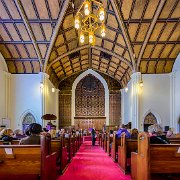
5 ST. JOHN’S CHRISTIAN METHODIST
EPISCOPAL CHURCH
8715 Woodward Avenue
Detroit, MI 48202
In 1917, the Reverend O. L. Mitchell established the first Colored Methodist Episcopal (CME) mission in Detroit. He selected the name St. John in honor of the Apostle who is credited with successfully establishing Christian churches throughout Asia Minor. The first CME church in Detroit was a brick church located near the intersection of DuBois and Catherine that had been erected in 1883 for the First German Evangelical Association Church. By 1920, a larger facility was needed, so the CME congregation purchased the former home of St. Mark’s English Evangelical Lutheran Church, also located near the intersection of Dubois and Catherine. The congregation used that facility until 1955 when they purchased the North Woodward Avenue Congregational building. With the move to the new location on June 5, 1955, St. John C.M.E. became the first Black congregation to be established in the “Piety Hill” section of Woodward.
The North Woodward Congregational Church was built in stages in the Neo Gothic style. A small chapel, designed by the firm of Malcomson and Higginbotham, was constructed early in 1907. The main sanctuary, designed by architect Hugh Barret Clement, was dedicated on February 5, 1911. On March 20, 1929, a permit was issued to architect A. R. Morison for the most recent addition, the church house. The three connected structures are built of red brick with limestone trim and a grey slate roof. Unlike many Gothic churches, it is a low-rise building lacking a bell tower. The projecting front gable wall containing a large Gothic-arched glass window dominates the Woodward Avenue facade.
The interior of the church is basilican in plan with a high central nave and lower side aisles. Large stained glass clerestory (upper) windows light the space which is finished in plaster with Gothic moldings. The organ is on the south side of the sanctuary facing the congregation, hidden behind a pierced wooden screen. The baptistery, a recess in the transept wall to the right of the chancel, is lined in mosaic tiles by Pewabic Pottery and surmounted by a Pewabic tile floor and beamed ceiling.
The official denominational name was changed to “Christian” in 1954. As the first C.M.E. church established in Michigan, it remains one of the largest and most well-known Christian Methodist congregations in the state.
EPISCOPAL CHURCH
8715 Woodward Avenue
Detroit, MI 48202
In 1917, the Reverend O. L. Mitchell established the first Colored Methodist Episcopal (CME) mission in Detroit. He selected the name St. John in honor of the Apostle who is credited with successfully establishing Christian churches throughout Asia Minor. The first CME church in Detroit was a brick church located near the intersection of DuBois and Catherine that had been erected in 1883 for the First German Evangelical Association Church. By 1920, a larger facility was needed, so the CME congregation purchased the former home of St. Mark’s English Evangelical Lutheran Church, also located near the intersection of Dubois and Catherine. The congregation used that facility until 1955 when they purchased the North Woodward Avenue Congregational building. With the move to the new location on June 5, 1955, St. John C.M.E. became the first Black congregation to be established in the “Piety Hill” section of Woodward.
The North Woodward Congregational Church was built in stages in the Neo Gothic style. A small chapel, designed by the firm of Malcomson and Higginbotham, was constructed early in 1907. The main sanctuary, designed by architect Hugh Barret Clement, was dedicated on February 5, 1911. On March 20, 1929, a permit was issued to architect A. R. Morison for the most recent addition, the church house. The three connected structures are built of red brick with limestone trim and a grey slate roof. Unlike many Gothic churches, it is a low-rise building lacking a bell tower. The projecting front gable wall containing a large Gothic-arched glass window dominates the Woodward Avenue facade.
The interior of the church is basilican in plan with a high central nave and lower side aisles. Large stained glass clerestory (upper) windows light the space which is finished in plaster with Gothic moldings. The organ is on the south side of the sanctuary facing the congregation, hidden behind a pierced wooden screen. The baptistery, a recess in the transept wall to the right of the chancel, is lined in mosaic tiles by Pewabic Pottery and surmounted by a Pewabic tile floor and beamed ceiling.
The official denominational name was changed to “Christian” in 1954. As the first C.M.E. church established in Michigan, it remains one of the largest and most well-known Christian Methodist congregations in the state.
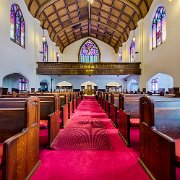
6 ST. JOHN’S CHRISTIAN METHODIST
EPISCOPAL CHURCH
8715 Woodward Avenue
Detroit, MI 48202
In 1917, the Reverend O. L. Mitchell established the first Colored Methodist Episcopal (CME) mission in Detroit. He selected the name St. John in honor of the Apostle who is credited with successfully establishing Christian churches throughout Asia Minor. The first CME church in Detroit was a brick church located near the intersection of DuBois and Catherine that had been erected in 1883 for the First German Evangelical Association Church. By 1920, a larger facility was needed, so the CME congregation purchased the former home of St. Mark’s English Evangelical Lutheran Church, also located near the intersection of Dubois and Catherine. The congregation used that facility until 1955 when they purchased the North Woodward Avenue Congregational building. With the move to the new location on June 5, 1955, St. John C.M.E. became the first Black congregation to be established in the “Piety Hill” section of Woodward.
The North Woodward Congregational Church was built in stages in the Neo Gothic style. A small chapel, designed by the firm of Malcomson and Higginbotham, was constructed early in 1907. The main sanctuary, designed by architect Hugh Barret Clement, was dedicated on February 5, 1911. On March 20, 1929, a permit was issued to architect A. R. Morison for the most recent addition, the church house. The three connected structures are built of red brick with limestone trim and a grey slate roof. Unlike many Gothic churches, it is a low-rise building lacking a bell tower. The projecting front gable wall containing a large Gothic-arched glass window dominates the Woodward Avenue facade.
The interior of the church is basilican in plan with a high central nave and lower side aisles. Large stained glass clerestory (upper) windows light the space which is finished in plaster with Gothic moldings. The organ is on the south side of the sanctuary facing the congregation, hidden behind a pierced wooden screen. The baptistery, a recess in the transept wall to the right of the chancel, is lined in mosaic tiles by Pewabic Pottery and surmounted by a Pewabic tile floor and beamed ceiling.
The official denominational name was changed to “Christian” in 1954. As the first C.M.E. church established in Michigan, it remains one of the largest and most well-known Christian Methodist congregations in the state.
EPISCOPAL CHURCH
8715 Woodward Avenue
Detroit, MI 48202
In 1917, the Reverend O. L. Mitchell established the first Colored Methodist Episcopal (CME) mission in Detroit. He selected the name St. John in honor of the Apostle who is credited with successfully establishing Christian churches throughout Asia Minor. The first CME church in Detroit was a brick church located near the intersection of DuBois and Catherine that had been erected in 1883 for the First German Evangelical Association Church. By 1920, a larger facility was needed, so the CME congregation purchased the former home of St. Mark’s English Evangelical Lutheran Church, also located near the intersection of Dubois and Catherine. The congregation used that facility until 1955 when they purchased the North Woodward Avenue Congregational building. With the move to the new location on June 5, 1955, St. John C.M.E. became the first Black congregation to be established in the “Piety Hill” section of Woodward.
The North Woodward Congregational Church was built in stages in the Neo Gothic style. A small chapel, designed by the firm of Malcomson and Higginbotham, was constructed early in 1907. The main sanctuary, designed by architect Hugh Barret Clement, was dedicated on February 5, 1911. On March 20, 1929, a permit was issued to architect A. R. Morison for the most recent addition, the church house. The three connected structures are built of red brick with limestone trim and a grey slate roof. Unlike many Gothic churches, it is a low-rise building lacking a bell tower. The projecting front gable wall containing a large Gothic-arched glass window dominates the Woodward Avenue facade.
The interior of the church is basilican in plan with a high central nave and lower side aisles. Large stained glass clerestory (upper) windows light the space which is finished in plaster with Gothic moldings. The organ is on the south side of the sanctuary facing the congregation, hidden behind a pierced wooden screen. The baptistery, a recess in the transept wall to the right of the chancel, is lined in mosaic tiles by Pewabic Pottery and surmounted by a Pewabic tile floor and beamed ceiling.
The official denominational name was changed to “Christian” in 1954. As the first C.M.E. church established in Michigan, it remains one of the largest and most well-known Christian Methodist congregations in the state.
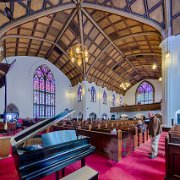
7 ST. JOHN’S CHRISTIAN METHODIST
EPISCOPAL CHURCH
8715 Woodward Avenue
Detroit, MI 48202
In 1917, the Reverend O. L. Mitchell established the first Colored Methodist Episcopal (CME) mission in Detroit. He selected the name St. John in honor of the Apostle who is credited with successfully establishing Christian churches throughout Asia Minor. The first CME church in Detroit was a brick church located near the intersection of DuBois and Catherine that had been erected in 1883 for the First German Evangelical Association Church. By 1920, a larger facility was needed, so the CME congregation purchased the former home of St. Mark’s English Evangelical Lutheran Church, also located near the intersection of Dubois and Catherine. The congregation used that facility until 1955 when they purchased the North Woodward Avenue Congregational building. With the move to the new location on June 5, 1955, St. John C.M.E. became the first Black congregation to be established in the “Piety Hill” section of Woodward.
The North Woodward Congregational Church was built in stages in the Neo Gothic style. A small chapel, designed by the firm of Malcomson and Higginbotham, was constructed early in 1907. The main sanctuary, designed by architect Hugh Barret Clement, was dedicated on February 5, 1911. On March 20, 1929, a permit was issued to architect A. R. Morison for the most recent addition, the church house. The three connected structures are built of red brick with limestone trim and a grey slate roof. Unlike many Gothic churches, it is a low-rise building lacking a bell tower. The projecting front gable wall containing a large Gothic-arched glass window dominates the Woodward Avenue facade.
The interior of the church is basilican in plan with a high central nave and lower side aisles. Large stained glass clerestory (upper) windows light the space which is finished in plaster with Gothic moldings. The organ is on the south side of the sanctuary facing the congregation, hidden behind a pierced wooden screen. The baptistery, a recess in the transept wall to the right of the chancel, is lined in mosaic tiles by Pewabic Pottery and surmounted by a Pewabic tile floor and beamed ceiling.
The official denominational name was changed to “Christian” in 1954. As the first C.M.E. church established in Michigan, it remains one of the largest and most well-known Christian Methodist congregations in the state.
EPISCOPAL CHURCH
8715 Woodward Avenue
Detroit, MI 48202
In 1917, the Reverend O. L. Mitchell established the first Colored Methodist Episcopal (CME) mission in Detroit. He selected the name St. John in honor of the Apostle who is credited with successfully establishing Christian churches throughout Asia Minor. The first CME church in Detroit was a brick church located near the intersection of DuBois and Catherine that had been erected in 1883 for the First German Evangelical Association Church. By 1920, a larger facility was needed, so the CME congregation purchased the former home of St. Mark’s English Evangelical Lutheran Church, also located near the intersection of Dubois and Catherine. The congregation used that facility until 1955 when they purchased the North Woodward Avenue Congregational building. With the move to the new location on June 5, 1955, St. John C.M.E. became the first Black congregation to be established in the “Piety Hill” section of Woodward.
The North Woodward Congregational Church was built in stages in the Neo Gothic style. A small chapel, designed by the firm of Malcomson and Higginbotham, was constructed early in 1907. The main sanctuary, designed by architect Hugh Barret Clement, was dedicated on February 5, 1911. On March 20, 1929, a permit was issued to architect A. R. Morison for the most recent addition, the church house. The three connected structures are built of red brick with limestone trim and a grey slate roof. Unlike many Gothic churches, it is a low-rise building lacking a bell tower. The projecting front gable wall containing a large Gothic-arched glass window dominates the Woodward Avenue facade.
The interior of the church is basilican in plan with a high central nave and lower side aisles. Large stained glass clerestory (upper) windows light the space which is finished in plaster with Gothic moldings. The organ is on the south side of the sanctuary facing the congregation, hidden behind a pierced wooden screen. The baptistery, a recess in the transept wall to the right of the chancel, is lined in mosaic tiles by Pewabic Pottery and surmounted by a Pewabic tile floor and beamed ceiling.
The official denominational name was changed to “Christian” in 1954. As the first C.M.E. church established in Michigan, it remains one of the largest and most well-known Christian Methodist congregations in the state.
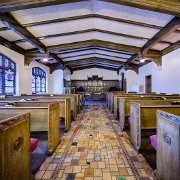
8 ST. JOHN’S CHRISTIAN METHODIST
EPISCOPAL CHURCH
8715 Woodward Avenue
Detroit, MI 48202
In 1917, the Reverend O. L. Mitchell established the first Colored Methodist Episcopal (CME) mission in Detroit. He selected the name St. John in honor of the Apostle who is credited with successfully establishing Christian churches throughout Asia Minor. The first CME church in Detroit was a brick church located near the intersection of DuBois and Catherine that had been erected in 1883 for the First German Evangelical Association Church. By 1920, a larger facility was needed, so the CME congregation purchased the former home of St. Mark’s English Evangelical Lutheran Church, also located near the intersection of Dubois and Catherine. The congregation used that facility until 1955 when they purchased the North Woodward Avenue Congregational building. With the move to the new location on June 5, 1955, St. John C.M.E. became the first Black congregation to be established in the “Piety Hill” section of Woodward.
The North Woodward Congregational Church was built in stages in the Neo Gothic style. A small chapel, designed by the firm of Malcomson and Higginbotham, was constructed early in 1907. The main sanctuary, designed by architect Hugh Barret Clement, was dedicated on February 5, 1911. On March 20, 1929, a permit was issued to architect A. R. Morison for the most recent addition, the church house. The three connected structures are built of red brick with limestone trim and a grey slate roof. Unlike many Gothic churches, it is a low-rise building lacking a bell tower. The projecting front gable wall containing a large Gothic-arched glass window dominates the Woodward Avenue facade.
The interior of the church is basilican in plan with a high central nave and lower side aisles. Large stained glass clerestory (upper) windows light the space which is finished in plaster with Gothic moldings. The organ is on the south side of the sanctuary facing the congregation, hidden behind a pierced wooden screen. The baptistery, a recess in the transept wall to the right of the chancel, is lined in mosaic tiles by Pewabic Pottery and surmounted by a Pewabic tile floor and beamed ceiling.
The official denominational name was changed to “Christian” in 1954. As the first C.M.E. church established in Michigan, it remains one of the largest and most well-known Christian Methodist congregations in the state.
EPISCOPAL CHURCH
8715 Woodward Avenue
Detroit, MI 48202
In 1917, the Reverend O. L. Mitchell established the first Colored Methodist Episcopal (CME) mission in Detroit. He selected the name St. John in honor of the Apostle who is credited with successfully establishing Christian churches throughout Asia Minor. The first CME church in Detroit was a brick church located near the intersection of DuBois and Catherine that had been erected in 1883 for the First German Evangelical Association Church. By 1920, a larger facility was needed, so the CME congregation purchased the former home of St. Mark’s English Evangelical Lutheran Church, also located near the intersection of Dubois and Catherine. The congregation used that facility until 1955 when they purchased the North Woodward Avenue Congregational building. With the move to the new location on June 5, 1955, St. John C.M.E. became the first Black congregation to be established in the “Piety Hill” section of Woodward.
The North Woodward Congregational Church was built in stages in the Neo Gothic style. A small chapel, designed by the firm of Malcomson and Higginbotham, was constructed early in 1907. The main sanctuary, designed by architect Hugh Barret Clement, was dedicated on February 5, 1911. On March 20, 1929, a permit was issued to architect A. R. Morison for the most recent addition, the church house. The three connected structures are built of red brick with limestone trim and a grey slate roof. Unlike many Gothic churches, it is a low-rise building lacking a bell tower. The projecting front gable wall containing a large Gothic-arched glass window dominates the Woodward Avenue facade.
The interior of the church is basilican in plan with a high central nave and lower side aisles. Large stained glass clerestory (upper) windows light the space which is finished in plaster with Gothic moldings. The organ is on the south side of the sanctuary facing the congregation, hidden behind a pierced wooden screen. The baptistery, a recess in the transept wall to the right of the chancel, is lined in mosaic tiles by Pewabic Pottery and surmounted by a Pewabic tile floor and beamed ceiling.
The official denominational name was changed to “Christian” in 1954. As the first C.M.E. church established in Michigan, it remains one of the largest and most well-known Christian Methodist congregations in the state.

9 ST. JOHN’S CHRISTIAN METHODIST
EPISCOPAL CHURCH
8715 Woodward Avenue
Detroit, MI 48202
In 1917, the Reverend O. L. Mitchell established the first Colored Methodist Episcopal (CME) mission in Detroit. He selected the name St. John in honor of the Apostle who is credited with successfully establishing Christian churches throughout Asia Minor. The first CME church in Detroit was a brick church located near the intersection of DuBois and Catherine that had been erected in 1883 for the First German Evangelical Association Church. By 1920, a larger facility was needed, so the CME congregation purchased the former home of St. Mark’s English Evangelical Lutheran Church, also located near the intersection of Dubois and Catherine. The congregation used that facility until 1955 when they purchased the North Woodward Avenue Congregational building. With the move to the new location on June 5, 1955, St. John C.M.E. became the first Black congregation to be established in the “Piety Hill” section of Woodward.
The North Woodward Congregational Church was built in stages in the Neo Gothic style. A small chapel, designed by the firm of Malcomson and Higginbotham, was constructed early in 1907. The main sanctuary, designed by architect Hugh Barret Clement, was dedicated on February 5, 1911. On March 20, 1929, a permit was issued to architect A. R. Morison for the most recent addition, the church house. The three connected structures are built of red brick with limestone trim and a grey slate roof. Unlike many Gothic churches, it is a low-rise building lacking a bell tower. The projecting front gable wall containing a large Gothic-arched glass window dominates the Woodward Avenue facade.
The interior of the church is basilican in plan with a high central nave and lower side aisles. Large stained glass clerestory (upper) windows light the space which is finished in plaster with Gothic moldings. The organ is on the south side of the sanctuary facing the congregation, hidden behind a pierced wooden screen. The baptistery, a recess in the transept wall to the right of the chancel, is lined in mosaic tiles by Pewabic Pottery and surmounted by a Pewabic tile floor and beamed ceiling.
The official denominational name was changed to “Christian” in 1954. As the first C.M.E. church established in Michigan, it remains one of the largest and most well-known Christian Methodist congregations in the state.
EPISCOPAL CHURCH
8715 Woodward Avenue
Detroit, MI 48202
In 1917, the Reverend O. L. Mitchell established the first Colored Methodist Episcopal (CME) mission in Detroit. He selected the name St. John in honor of the Apostle who is credited with successfully establishing Christian churches throughout Asia Minor. The first CME church in Detroit was a brick church located near the intersection of DuBois and Catherine that had been erected in 1883 for the First German Evangelical Association Church. By 1920, a larger facility was needed, so the CME congregation purchased the former home of St. Mark’s English Evangelical Lutheran Church, also located near the intersection of Dubois and Catherine. The congregation used that facility until 1955 when they purchased the North Woodward Avenue Congregational building. With the move to the new location on June 5, 1955, St. John C.M.E. became the first Black congregation to be established in the “Piety Hill” section of Woodward.
The North Woodward Congregational Church was built in stages in the Neo Gothic style. A small chapel, designed by the firm of Malcomson and Higginbotham, was constructed early in 1907. The main sanctuary, designed by architect Hugh Barret Clement, was dedicated on February 5, 1911. On March 20, 1929, a permit was issued to architect A. R. Morison for the most recent addition, the church house. The three connected structures are built of red brick with limestone trim and a grey slate roof. Unlike many Gothic churches, it is a low-rise building lacking a bell tower. The projecting front gable wall containing a large Gothic-arched glass window dominates the Woodward Avenue facade.
The interior of the church is basilican in plan with a high central nave and lower side aisles. Large stained glass clerestory (upper) windows light the space which is finished in plaster with Gothic moldings. The organ is on the south side of the sanctuary facing the congregation, hidden behind a pierced wooden screen. The baptistery, a recess in the transept wall to the right of the chancel, is lined in mosaic tiles by Pewabic Pottery and surmounted by a Pewabic tile floor and beamed ceiling.
The official denominational name was changed to “Christian” in 1954. As the first C.M.E. church established in Michigan, it remains one of the largest and most well-known Christian Methodist congregations in the state.
St. John Christian Methodist Church